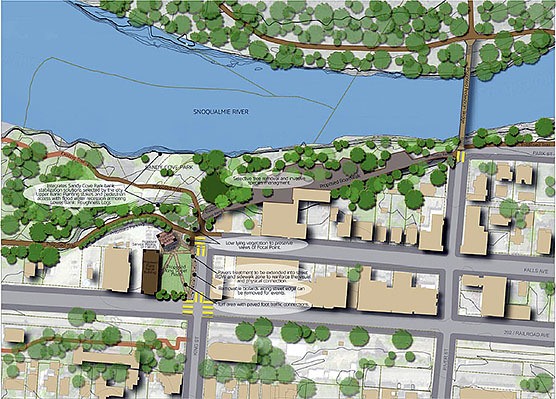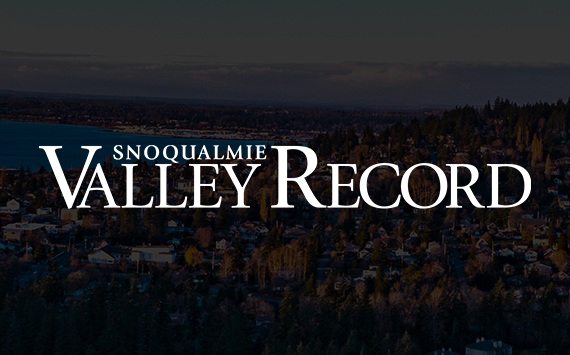More than 1 million people visit Snoqualmie Falls each year, bringing spending money, and economic stimulation with them. They don’t necessarily visit the city of Snoqualmie, though.
Changing that pattern is the goal of an extensive project, already one year in, to develop Snoqualmie itself as a tourist destination.
Snoqualmie’s City Council was updated on the project Monday, Jan. 26, when planning consultant Brent Harley presented the Snoqualmie Riverwalk master plan. Broadly, the plan is to create a series of trails along and across the Snoqualmie River, connecting historic downtown and the mill pond area with traffic generated by Snoqualmie Falls.
Possible features include a pedestrian bridge across the Snoqualmie River at River Street, a gateway at the Snoqualmie Parkway intersection with S.R. 202, paved and gravel trails circling Borst Lake and connecting to the Falls viewing area and passing through natural areas and downtown as they link to the Snoqualmie Valley Trail at Tokul Road and the Meadowbrook Bridge.
Harley was enthusiastic about the potential for development at several sites, such as a town focal point in the King Street plaza, and a canopy trail at the Meadowbrook Bridge.
The trail, in particular, he said, was “a great opportunity, absolutely iconic.” The idea is for an elevated walkway starting at the Meadowbrook Bridge and running parallel to the Snoqualmie Valley Trail, then gradually descending to ground level.
“A lot of this has been tied into the whole idea of Snoqualmie taking on tourism as a key economic element,” Harley said.
The project’s vision is to “create the Snoqualmie Riverwalk as a distinctive, unique-to-Snoqualmie trail system, linking the Snoqualmie River to key city focal points while acting as an attraction and community amenity that provides an inspiring experience to visitors and residents alike.”
It is also a six-phase proposition that will require support from the state Highway Department and other government entities, plus solutions to the problems of parking and growth limitations, Harley said.
Since downtown economic development was one of the primary goals of the visioning process, Harley said trails and amenities in the downtown core would be a good first phase. Next, he suggested the gateway at the Snoqualmie Parkway, then the connections from the falls to downtown. The final three phases would be: Four, building up amenities on the north shore of the Snoqualmie River, opposite the city; five, improvements in the Meadowbrook district, such as the canopy trail; and six, a trail system on the north shore.
“All of the stuff that I’m talking about, it can’t be built at once,” he said. Further, “each one of these phases has to be a stand-alone,” in case the city never gets to the next phase.
Some elements will also require creative solutions, such as visitor parking, which is limited. Harley told the council that 1,200 feet is “the magic number,” the distance a tourist will generally walk before rejecting a destination. Also, pedestrian improvements, essential to the success of such a trail system, would be required on the state-owned S.R. 202 bridge over the Snoqualmie River.
Costs were not discussed, but Harley did have several recommendations for next steps. In addition to beginning design work on phase-one improvements, he advised the council to work on securing the needed development rights, and to formalize a city tourism strategy, as well as a wayfinding master plan for directional and informational signs.
During the presentation, Councilman Bryan Holloway questioned the possibilities for King Street, noting that the area was in a floodway. Planning Director Nancy Tucker responded that the city’s planning department had worked hard and successfully gotten the floodway maps changed to allow for development on the site.
Councilwoman Shelley Patterson asked how important camping was in the master plan, because “I didn’t hear the word ‘camping’ in this entire presentation.”
Harley answered that camping was in the master plan, and he hadn’t discussed it, but “it can be given all sorts of emphasis,” when the city begins planning visitor amenities.
Finally, Harley told the council that the riverwalk was “a very exciting project…You guys have this huge, huge opportunity here.”
The Snoqualmie Riverwalk master plan presentation is available on the city of Snoqualmie’s website, www.ci.snoqualmie.wa.us.

Design elements for the north shore of the Snoqualmie Riverwalk include an elevated “canopy trail.”


